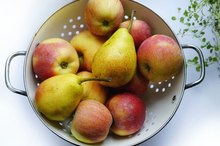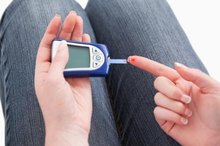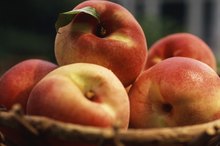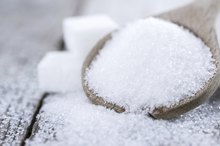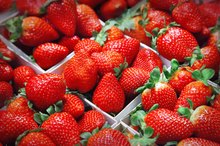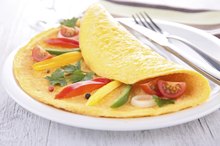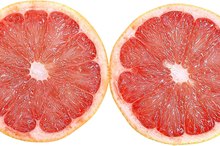What Fruits to Avoid for Diabetic & Uric Acid Patients
Diet is important for both diabetes and gout, two chronic metabolic diseases 6. In diabetes, the body has a problem managing blood glucose because insulin is too low or cells respond abnormally to insulin. As a result, blood sugar may become too high, compromising the body's energy supply. In gout, the body has a problem metabolizing purines, natural compounds found in many foods. Breakdown of purines produces uric acid, which may crystallize in joints of gout patients and cause severe pain 2. Both gout patients and diabetics should avoid certain foods, including some fruits that are either rich in purines or that have lots of simple sugar. Consult a doctor to determine a dietary regimen that is appropriate for you 2.
If you are experiencing serious medical symptoms, seek emergency treatment immediately.
Bananas
Bananas are a low-purine, high vitamin C food that can lower uric acid levels 2. Lowering uric acid can reduce the risk of gout attacks, but please talk to a medical professional and continue to take your prescribed medication. For diabetics, you should be mindful of the high simple sugar fructose in a banana -- about 20 g in 100 g of banana. High sugar foods cause a rapid increase in blood sugar, a situation that is unhealthy for diabetic patients.
- Although bananas are healthy foods in general, they are not a good choice for patients with either gout or diabetes 2.
- Diabetics should also avoid eating bananas regularly, because they are high in the simple sugar fructose, with about 20 g in 100 g of banana.
Grapes
3 Types of Fruits Best for People With Gout
Learn More
Grapes contain significant amounts of both purines and simple sugars, making them poor dietary choices for diabetics and for patients with gout. A serving of green grapes, or 100 g, contains almost 30 mg of purines; this amount of fruit also provides 15 g of simple sugar. Patients should choose other fruits such as cantaloupe or grapefruit, which are low in both sugar and purines.
Raisins and Other Dried Fruits
Patients suffering from gout should avoid raisins since these fruits are produced from grapes, which are purine-rich fruits. Diabetics should also avoid raisins and other dried fruits such as dried apricots and figs 6. Drying these fruits concentrates their sugars, making them very rich in simple sugar. As a result, consuming dried fruits may cause a rapid and unhealthy rise in blood sugar in diabetic patients 6.
Related Articles
References
- Health Castle: Gout
- Dietary Fiber Food: Gout Causes: Diet/Food With High or Low Uric Acid Content
- Fat Free Kitchen: Fruit Nutrition Data
- MayoClinic.com: Gout
- Health Hubs: Diabetes - What Fruits Can A Diabetic Eat?
- U.S. Department of Health and Human Services and U.S. Department of Agriculture. 2015–2020 Dietary Guidelines for Americans. 8th Edition. Published December 2015.
- U.S. Department of Health and Human Services. Gripped by Gout. NIH News in Health. Published February 2014.
- National Institute of Arthritis and Musculoskeletal and Skin Diseases. Gout. Updated April 2016.
- Zhang Y, Chen C, Choi H, et al. Purine-rich foods intake and recurrent gout attacks. Ann Rheum Dis. 2012; 71(9):1448-53. doi:10.1136/annrheumdis-2011-201215
- Fischer E. Ueber die Harnsauer. 1 [On Uric Acid. 1]. Berichte der Deutschen Chemischen Gesellschaft. 1884: 17:328-338. doi:10.1002/cber.18980310304
- Ragab, G., Elshahaly, M., & Bardin, T. (2017). Gout: An old disease in new perspective – A review. Journal of Advanced Research, 8(5), 495–511. doi:10.1016/j.jare.2017.04.008
- Centers for Disease Control and Prevention. Gout. Updated January 28, 2019.
- Zgaga, L., Theodoratou, E., Kyle, J., Farrington, S. M., Agakov, F., Tenesa, A., … Campbell, H. (2012). The Association of Dietary Intake of Purine-Rich Vegetables, Sugar-Sweetened Beverages and Dairy with Plasma Urate, in a Cross-Sectional Study. PLoS ONE, 7(6), e38123. doi:10.1371/journal.pone.0038123
- Choi HK, Gao X, Curhan G. Vitamin C intake and the risk of gout in men: a prospective study. Arch Intern Med. 2009;169(5):502–507. doi:10.1001/archinternmed.2008.606
- Zhang Y, Neogi T, Chen C, Chaisson C, Hunter DJ, Choi HK. Cherry consumption and decreased risk of recurrent gout attacks. Arthritis Rheum. 2012;64(12):4004–4011. doi:10.1002/art.34677
- Arthritis Foundation. Gout Diet: Dos and Don’ts.
- Boban M, Modun D. Uric acid and antioxidant effects of wine. Croat Med J. 2010;51(1):16–22. doi:10.3325/cmj.2010.51.16
- Caliceti C, Calabria D, Roda A, Cicero AFG. Fructose Intake, Serum Uric Acid, and Cardiometabolic Disorders: A Critical Review. Nutrients. 2017;9(4):395. Published 2017 Apr 18. doi:10.3390/nu9040395
- U.S. Department of Health and Human Services and U.S. Department of Agriculture. 2015–2020 Dietary Guidelines for Americans. 8th Edition. Published December 2015.
- U.S. Department of Health and Human Services. Gripped by Gout. NIH News in Health. Published February 2014.
- Kakutani-Hatayama M, Kadoya M, Okazaki H, et al. Nonpharmacological Management of Gout and Hyperuricemia: Hints for Better Lifestyle. Am J Lifestyle Med. 2015;11(4):321–329. Published 2015 Sep 2. doi:10.1177/1559827615601973
Writer Bio
Joanne Marie began writing professionally in 1981. Her work has appeared in health, medical and scientific publications such as Endocrinology and Journal of Cell Biology. She has also published in hobbyist offerings such as The Hobstarand The Bagpiper. Marie is a certified master gardener and has a Ph.D. in anatomy from Temple University School of Medicine.
